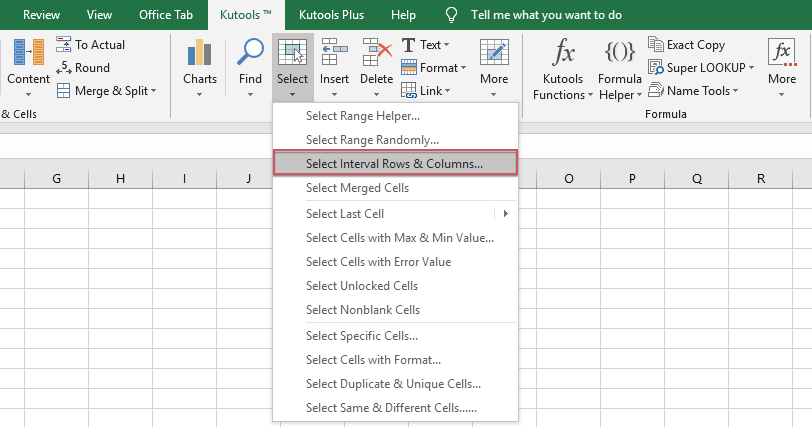如何快速求和Excel中的每隔第n行/第n行?
众所周知,我们可以应用Sum函数添加一个单元格列表,但有时出于某种目的我们需要对其他所有单元格求和,而Excel没有标准函数允许我们对第n个单元格求和。 在这种情况下,我们如何才能在Excel中隔行相加或第n行/列相加?
使用 Kutools for Excel 每隔或第 n 行/列求和/平均/计数
每隔一个或第n行/列与公式求和
通过以下示例,我将向您展示如何应用将所有其他单元格相加的公式。
1.使用数组公式对其他所有行或列求和
在空白单元格中,请输入以下公式: =SUM(IF(MOD(ROW($B$1:$B$15),2)=0,$B$1:$B$15,0)), 然后按 Ctrl + Shift + Enter 键,以及B列中的所有其他单元格值都已求和。 查看屏幕截图:
 |
 |
 |
笔记:
1.在上面的数组公式中,您可以将数字2更改为3、4、5…,这意味着每3行,每4行,每5行求和…
2.如果要对其他所有列求和,则可以输入以下公式: =SUM(IF(MOD(COLUMN($A$1:$O$1),2)=0,$A$1:$O$1,0)),然后按 Ctrl + Shift + Enter 获得结果的键。 看截图:

2.使用公式对其他所有行或列求和
这是另一个公式,可以帮助您对工作表中的每隔n个单元格求和。
在一个空单元格中,请输入以下公式: =SUMPRODUCT((MOD(ROW($B$1:$B$15),3)=0)*($B$1:$B$15))。 然后按 输入 键,并添加了每个第三个单元格。 查看屏幕截图:
 |
 |
 |
笔记:
1.在上面的公式中,您可以将数字3更改为4、5、6…,这意味着每4行,每5行,每6行求和……
2.如果要对其他所有列求和,则可以输入以下公式: =SUMPRODUCT((MOD(COLUMN($A$1:$O$1),3)=0)*($A$1:$O$1)).

使用用户定义的函数求和每隔第n行/第n行
以下用户定义的函数还可以帮助您在Excel中添加每隔第n个单元格。
1。 按住 ALT + F11 键,然后打开 Microsoft Visual Basic应用程序 窗口。
2。 点击 插页 > 模块,然后将以下代码粘贴到“模块”窗口中。
Function SumIntervalRows(WorkRng As Range, interval As Integer) As Double
'Updateby Extendoffice
Dim arr As Variant
Dim total As Double
total = 0
arr = WorkRng.Value
For i = interval To UBound(arr, 1) Step interval
total = total + arr(i, 1)
Next
SumIntervalRows = total
End Function
Function SumIntervalCols(WorkRng As Range, interval As Integer) As Double
Dim arr As Variant
Dim total As Double
total = 0
arr = WorkRng.Value
For j = interval To UBound(arr, 2) Step interval
total = total + arr(1, j)
Next
SumIntervalCols = total
End Function
3。 然后保存此代码,并根据需要在空白单元格中键入以下公式,请参见屏幕截图:
用于汇总第四行: = SumIntervalRows(B1:B15,4)

用于汇总第四列: = SumIntervalCols(A1:O1,4)

4。 然后按 输入 键,您将得到计算。 查看屏幕截图:
每四行求和:

每四列求和:

备注:您可以将数字4更改为任何其他数字,例如2、3、5…,这意味着每隔第二行,每隔第三行,每隔第五行或每列求和。
使用 Kutools for Excel 每隔或第 n 行/列求和/平均/计数
也许对于大多数人来说,公式和用户定义函数都有些困难,在这里,我可以向您介绍一种解决此任务的简便方法。
Kutools for Excel“ 选择间隔行和列,您可以先选择每个其他或第n个单元格,然后使用Sum函数对单元格求和,为选定的单元格定义一个名称。
| Kutools for Excel : 带有300多个便捷的Excel加载项,可以在30天内免费试用. |
安装后 Kutools for Excel,请执行以下步骤:
1。 选择要对每隔两个或第n个单元求和的列。
2。 点击 库工具 > 选择 > 选择间隔行和列,请参见屏幕截图:

3。 在 选择间隔行和列 对话框中,根据需要指定操作,请参见屏幕截图:
4。 点击 OK,并且已经从第一行中选择了每隔一行,现在,您可以查看计算的结果,例如平均值,总和,计数显示在状态栏的底部。 看截图:

笔记:
1.使用此功能,您可以在中设置数字2、3、4… 间隔 选项,然后从第2步中范围的第一行开始选择间隔为3、4、3行的单元格。
2.通过上述步骤,您还可以根据需要对每隔第n列进行求和。
如果您想进一步了解此功能,请单击 选择间隔行和列.
演示:使用 Kutools for Excel 每隔或第 n 行/列求和/平均/计数
相关文章:
最佳办公生产力工具
| 🤖 | Kutools 人工智能助手:基于以下内容彻底改变数据分析: 智能执行 | 生成代码 | 创建自定义公式 | 分析数据并生成图表 | 调用 Kutools 函数... |
| 热门特色: 查找、突出显示或识别重复项 | 删除空白行 | 合并列或单元格而不丢失数据 | 不使用公式进行四舍五入 ... | |
| 超级查询: 多条件VLookup | 多值VLookup | 跨多个工作表的 VLookup | 模糊查询 .... | |
| 高级下拉列表: 快速创建下拉列表 | 依赖下拉列表 | 多选下拉列表 .... | |
| 列管理器: 添加特定数量的列 | 移动列 | 切换隐藏列的可见性状态 | 比较范围和列 ... | |
| 特色功能: 网格焦点 | 设计图 | 大方程式酒吧 | 工作簿和工作表管理器 | 资源库 (自动文本) | 日期选择器 | 合并工作表 | 加密/解密单元格 | 按列表发送电子邮件 | 超级筛选 | 特殊过滤器 (过滤粗体/斜体/删除线...)... | |
| 前 15 个工具集: 12 文本 工具 (添加文本, 删除字符,...) | 50+ 图表 类型 (甘特图,...) | 40+ 实用 公式 (根据生日计算年龄,...) | 19 插入 工具 (插入二维码, 从路径插入图片,...) | 12 转化 工具 (小写金额转大写, 货币兑换,...) | 7 合并与拆分 工具 (高级组合行, 分裂细胞,...) | ... 和更多 |
使用 Kutools for Excel 增强您的 Excel 技能,体验前所未有的效率。 Kutools for Excel 提供了 300 多种高级功能来提高生产力并节省时间。 单击此处获取您最需要的功能...

Office Tab 为 Office 带来选项卡式界面,让您的工作更加轻松
- 在Word,Excel,PowerPoint中启用选项卡式编辑和阅读,发布者,Access,Visio和Project。
- 在同一窗口的新选项卡中而不是在新窗口中打开并创建多个文档。
- 每天将您的工作效率提高50%,并减少数百次鼠标单击!

